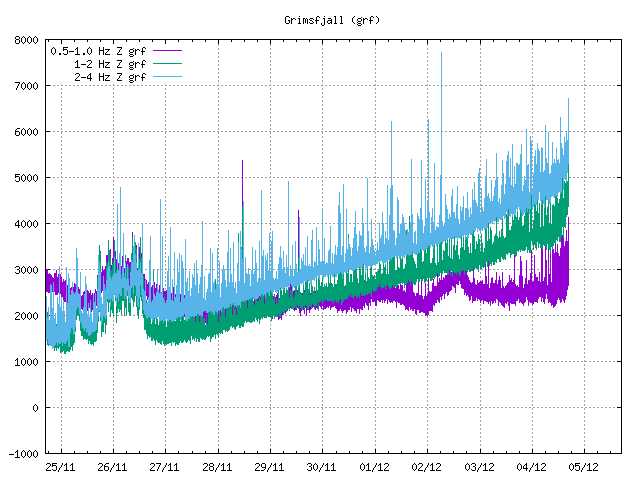I’ve been trying to wait for information about the activity in Grímsfjall volcano. A new cauldron was discovered yesterday (05-December-2021). It is possible that an small eruption took place in the side of Grímsfjall volcano and didn’t break the glacier. It might have been a short eruption if that is what happened. Harmonic tremor data is unclear on this so I can’t give any good answer. At 06:16 UTC an earthquake with magnitude of Mw3,6 took place. I poorly recorded it my seismometer and it seems to have been a low period earthquake. Suggesting that a magma pushing up was the reason this earthquake happened.
Continue reading “Earthquake with magnitude Mw3,6 in Grímsfjall volcano, no eruption yet”
Sharp change in harmonic tremor in Grímsfjall volcano
This situation is unclear and nothing has been confirmed as of writing of this article. This seems to have started about 1 hour ago and there has been a change in the harmonic tremor levels at Grímsfjall volcano. This is not yet the super sharp change I did see in May-2011 when that eruption happened. This is however is possibly a change in harmonic tremor that is consistent with magma moving inside the volcano system. Earthquake activity has been minimal in the last 24 hours.

This is a monitoring situation currently. Sometimes an eruption happens after a glacier flood or doing a glacier flood in Grímsfjall volcano. At other times however nothing happens and it is not possible to know what happens now.
Donations
Please remember to support my work with donations. Thanks for the support. 🙂
Earthquake in Vatnafjöll mountain during the night
At 03:17 UTC on 26-November-2021 an earthquake with magnitude of Mw3,5 took place in Vatnafjöll mountains that are south of Hekla volcano. This earthquake was not felt or it was not reported to Icelandic Met Office.
Continue reading “Earthquake in Vatnafjöll mountain during the night”
Glacier flood starting from Grímsfjall volcano
It was announced today (24-November-2021) that Grímsvötn lake in Grímsfjall volcano is about to start. It is going to take the glacier flood few hours to days to get to the glacier rivers that flow south of Vatnajökull glacier.
This also risks an eruption starting in Grímsfjall volcano. If that actually happens remains to be seen. Last glacier flood in Grímsvötn lake was in 2018, but that did not result in a eruption.
Large earthquake swarm in Reykjanes volcano
Yesterday (20-November-2021) an large earthquake swarm started in Reykjanes volcano. This earthquake swarm is rather large, with 217 earthquakes recorded so far. Largest earthquake had a magnitude of Mw3,5 but other earthquakes have been smaller in magnitude.
Continue reading “Large earthquake swarm in Reykjanes volcano”
Ongoing earthquake swarm in Vatnafjöll mountain south of Hekla volcano
The earthquake activity south of Hekla volcano is ongoing and the largest earthquakes in recent days have had a magnitude of Mw3,8 and Mw3,3. Other earthquakes in recent days have been smaller. The largest earthquakes have been felt in nearby farms and Hvolvollur town and in Hella town.
Continue reading “Ongoing earthquake swarm in Vatnafjöll mountain south of Hekla volcano”
Earthquake activity in Brennisteinsfjölll volcano
Yesterday (18-November-2021 and on 17-November-2021) an earthquake swarm took place in Brennisteinsfjöll volcano. Two of the largest earthquakes where Mw3,3 magnitude in size.
Continue reading “Earthquake activity in Brennisteinsfjölll volcano”
Deep inflation detected in Fagradalsfjall mountain
According to a news report today (16-November-2021) inflation has been detected deep under Fagradalsfjall mountain, that is part of Krýsuvík-Trölladyngja volcano system. This inflation suggests that an eruption might start again in Fagradalsfjall mountain, it remains impossible to know when such an eruption might start. Since there is a lot that suggest this inflation is because of magma collecting at depth under Fagradalsfjall mountain. When or if that results in a eruption in the future is impossible to know.
This inflation is now large enough to be seen on satellite images that monitors deformation in the upper crust. In the upper crust this deformation appears small, but that is not all the story in this.
Icelandic News (in Icelandic)
Gosið enn í dvala – Mæla litlar hreyfingar á miklu dýpi (Rúv.is)
Donations
Please remember to support me. In November I am really broke in November because of computer repairs. Thanks for the support. 🙂
Strong aftershock in Vatnafjöll mountains (south of Hekla volcano)
Yesterday (13-November-2021) at 23:23 UTC an earthquake with magnitude of Mw3,4 took place in Vatnafjöll mountain south of Hekla volcano. This looks like an aftershock of the main earthquake of magnitude Mw5,2 that took place on 11-November-2021.
Continue reading “Strong aftershock in Vatnafjöll mountains (south of Hekla volcano)”
Two strong earthquakes in Bárðarbunga volcano
Today (12-November-2021) at 15:16 and 15:35 two earthquakes with magnitudes of Mw3,3 and Mw3,6 took place in Bárðarbunga volcano.
Continue reading “Two strong earthquakes in Bárðarbunga volcano”
